1mg
Showing 3251–3300 of 4612 results
-
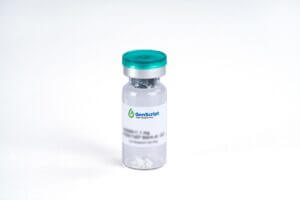
FGF-acidic, Mouse
$612.38 Add to cart View Product DetailsFibroblast Growth Factor- acidic (FGF-acidic) is a mitogen targeting at the endothelial cells, and belongs to the heparin binding FGF family, which contains 22 members. FGF-acidic binds to the receptor family FGFR1-4 in vivo with the assistance of heparin. However, along with FGF -basic, FGF-acidic lacks the signal peptide segment, and thus is not secreted via endoplasmic reticulum (ER) and Golgi bodies. Studies have shown that FGF-acidic is highly regulated, and it is a direct angiogenesis factor. If unregulated, angiogenesis could contribute to several diseases including arthritis, diabetes, ocular neovascularization, and especially tumors. Therefore, FGF-acidic is treated as a potential oncogene, and its overexpression is correlated tightly with several cancers.
-

FGF-basic (145aa), Human
$543.38 Add to cart View Product DetailsFibroblast Growth Factor-basic (FGF-basic), also known as FGF-2, is a pleiotropic cytokine and one of the prototypic members of the heparin-binding FGF family. Like other FGF family members, FGF-basic has the β trefoil structure. In vivo, FGF-basic is produced by a variety of cells, including cardiomycotes, fibroblasts, and vascular cells. FGF-basic regulates a variety of processes including cell proliferation, differentiation, survival, adhesion, motility, apoptosis, limb formation and wound healing. FGF-basic can be tumorigenic due to its role in angiogenesis and blood vessel remodeling. The angiogenic effects of FGF-basic can produce beneficial cardioprotection during acute heart injury.
-

FGF-basic (146aa), Human
$586.50 Add to cart View Product DetailsFibroblast Growth Factor-basic (FGF-basic), also known as FGF-2, is a pleiotropic cytokine and one of the prototypic members of the heparin-binding FGF family. Like other FGF family members, FGF-basic has the β trefoil structure. In vivo, FGF-basic is produced by a variety of cells, including cardiomycotes, fibroblasts, and vascular cells. FGF-basic regulates a variety of processes including cell proliferation, differentiation, survival, adhesion, motility, apoptosis, limb formation and wound healing. FGF-basic can be tumorigenic due to its role in angiogenesis and blood vessel remodeling. The angiogenic effects of FGF-basic can produce beneficial cardioprotection during acute heart injury.
-

FGF-basic (154aa), Human
$612.38 Add to cart View Product DetailsFibroblast Growth Factor-basic (FGF-basic), also known as FGF-2, is a pleiotropic cytokine and one of the prototypic members of the heparin-binding FGF family. Like other FGF family members, bFGF has the β trefoil structure. In vivo, bFGF is produced by a variety of cells, including cardiomycotes, fibroblasts, and vascular cells. bFGF regulates a variety of processes including cell proliferation, differentiation, survival, adhesion, motility, apoptosis, limb formation and wound healing. bFGF can be tumorigenic due to its role in angiogenesis and blood vessel remodeling. The angiogenic effects of bFGF can produce beneficial cardioprotection during acute heart injury.
-

FGF-basic, Bovine
$612.38 Add to cart View Product DetailsFibroblast Growth Factor-basic (FGF-basic), also known as FGF-2, is a pleiotropic cytokine and one of the prototypic members of the heparin-binding FGF family. Like other FGF family members, FGF-basic has the β trefoil structure. In vivo, FGF-basic is produced by a variety of cells, including cardiomycotes, fibroblasts, and vascular cells. FGF-basic regulates a variety of processes including cell proliferation, differentiation, survival, adhesion, motility, apoptosis, limb formation and wound healing. FGF-basic can be tumorigenic due to its role in angiogenesis and blood vessel remodeling. The angiogenic effects of FGF-basic can produce beneficial cardioprotection during acute heart injury.
-
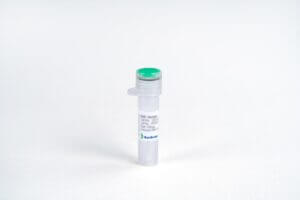
FGF-basic, Mouse
$612.38 Add to cart View Product DetailsFibroblast Growth Factor-basic (FGF-basic), also known as HBGF-2, is a non-glycosylated heparin-binding growth factor that belongs to the FGF family. FGF-basic is present in basement membranes and in the subendothelial extracellular matrix of blood vessels. FGF-basic signals through FGFR1, 2, 3 and 4 that plays an important role in the regulation of cell survival, cell division, angiogenesis, cell differentiation and cell migration.
-
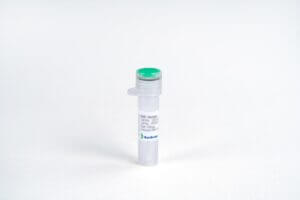
FGF-basic, Rat
$612.38 Add to cart View Product DetailsFibroblast Growth Factor-basic (FGF-basic), also known as FGF-2, is a pleiotropic cytokine and one of the prototypic members of the heparin-binding FGF family. Like other FGF family members, FGF-basic has the β trefoil structure. In vivo, FGF-basic is produced by a variety of cells, including cardiomycotes, fibroblasts, and vascular cells. FGF-basic regulates a variety of processes including cell proliferation, differentiation, survival, adhesion, motility, apoptosis, limb formation and wound healing. FGF-basic can be tumorigenic due to its role in angiogenesis and blood vessel remodeling. The angiogenic effects of FGF-basic can produce beneficial cardioprotection during acute heart injury.
-

FGF-basic, Salmon
$1,138.50 Add to cart View Product DetailsFibroblast Growth Factor-basic (FGF-basic), also known as FGF-2, is a pleiotropic cytokine and one of the prototypic members of the heparin-binding FGF family. Like other FGF family members, FGF-basic has the β trefoil structure. In vivo, FGF-basic is produced by a variety of cells, including cardiomyocytes, fibroblasts, and vascular cells. FGF-basic regulates a variety of processes including cell proliferation, differentiation, survival, adhesion, motility, apoptosis, limb formation and wound healing. FGF-basic can be tumorigenic due to its role in angiogenesis and blood vessel remodeling. The angiogenic effects of FGF-basic can produce beneficial cardioprotection during acute heart injury.
-
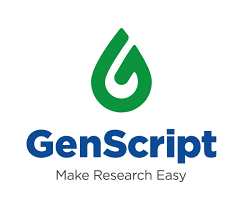
FGF-R2β Fc Chimera, Mouse
$1,293.75 Add to cart View Product DetailsFibroblast growth factor receptor 2 (FGFR2) also known as CD332 is a receptor for fibroblast growth factor and it has important roles in embryonic development and tissue repair, especially bone and blood vessels. FGFR2 has two naturally occurring isoforms, FGFR2IIIb and FGFR2IIIc, created by splicing of the third immunoglobulin-like domain. FGFR2IIIb is predominantly found in ectoderm derived tissues and endothelial organ lining. Like the other members of the fibroblast growth factor receptor family, these receptors signal by binding to their ligand and dimerisation (pairing of receptors), which causes the tyrosine kinase domains to initiate a cascade of intracellular signals. On a molecular level these signals mediate cell division, growth and differentiation.
-

FGF-R3(ⅢC) Fc Chimera, Mouse
$1,293.75 Add to cart View Product DetailsFibroblast growth factor receptor 3(FGFR3) also known as CD333 (cluster of differentiation 333) is a member of the fibroblast growth factor receptor family, where amino acid sequence is highly conserved between members and throughout evolution. The FGFR3 gene produces various forms of the FGFR3 protein and the location varies depending on the isoform of the FGFR3 protein. Since the different forms are found within different tissues, the protein is responsible for multiple growth factor interactions. Gain of function mutations in FGFR3 inhibits chondrocyte proliferation and underlies achondroplasia and hypochondroplasia.
-

FGF-R4 Fc Chimera, Mouse
$1,293.75 Add to cart View Product DetailsFibroblast growth factor receptor 4(FGFR4) also known as CD334 (cluster of differentiation 334) is a member of the fibroblast growth factor receptor family, where amino acid sequence is highly conserved between members and throughout evolution. A full-length representative protein would consist of an extracellular region, composed of three immunoglobulin-like domains, a single hydrophobic membrane-spanning segment and a cytoplasmic tyrosine kinase domain. The extracellular portion of the protein interacts with fibroblast growth factors, setting in motion a cascade of downstream signals, ultimately influencing mitogenesis and differentiation.
-

FGL1 Fc Chimera, Human
$1,293.75 Add to cart View Product DetailsFGL1 (Fibrinogen-like protein 1), also known as hepatocyte-derived fibrinogen-related protein 1 (HFREP-1), HP-041, hepassocin (HPS), and liver fibrinogen-related protein 1 (LFIRE-1), is a liver-specific secreted protein belonging to the fibrinogen superfamily whose members share a fibrinogen domain at their C-termini. FGL1 is an immune suppressive molecule that inhibits the activation of antigen-specific T cells by acting as a major ligand of LAG3, and binds LAG3 independently of MHC class II.
-

Filipin III
$199.24 Add to cart View Product DetailsMolecular Formula : C35H58O11
-

Finasteride-d9
$183.71 Add to cart View Product DetailsMolecular Formula : C23 2H9 H27 N2 O2
-

Fingolimod-d4 Hydrochloride
$174.23 Add to cart View Product DetailsMolecular Formula : C19H30D4ClNO2
-
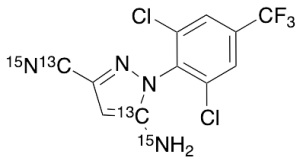
Fipronil Detrifluoromethylsulfinyl-13C2 15N2
$224.25 Add to cart View Product DetailsMolecular Formula : C913C2H5Cl2F3N215N2
-
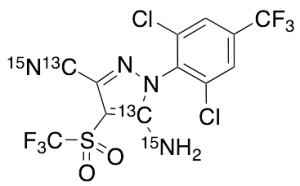
Fipronil Sulfone-13C2,15N2
$418.31 Add to cart View Product DetailsMolecular Formula : C1013C2H4Cl2F6N215N2O2S
-

Fipronil- 13C2 15N2
$366.56 Add to cart View Product DetailsMolecular Formula : C1013C2H4Cl2F6N215N2OS
-
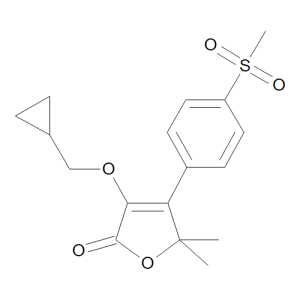
Firocoxib
$79.35 Add to cart View Product DetailsMolecular Formula : C17 H20 O5 S
-
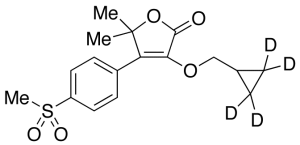
Firocoxib-d4
$238.05 Add to cart View Product DetailsMolecular Formula : C17 2H4 H16 O5 S
-

FITC-Protein L
$120.75 Add to cart View Product DetailsProtein L is a cell surface protein from Peptostreptoccocus magnus that binds to the variable light chains (kappa chain) of immunoglobulins without interfering with antigen binding. In contrast to IgG-binding proteins, such as protein A and protein G, which bind to the Fc region of immunoglobulins, protein L can be used for the detection and purification of mammalian kappa light chain antibodies of all classes. Since no part of the heavy chain is involved in the binding interaction, Protein L binds a wider range of antibody classes than Protein A or G. Protein L binds to representatives of all antibody classes, including IgG, IgM, IgA, IgE and IgD. Single chain variable fragments (scFv) and Fab fragments also bind to Protein L.
-

Flavine Adenine Dinucleotide-13C5 Ammonium Salt
$3,342.19 Add to cart View Product DetailsMolecular Formula : C2213C5H33N9O15P2 xNH3
-

Flavokavain B
$69.00 Add to cart View Product DetailsMolecular Formula : C17 H16 O4
-

Flavoxate-d4 Hydrochloride
$162.15 Add to cart View Product DetailsMolecular Formula : C24H22D4ClNO4
-

Flecainide-d3
$242.36 Add to cart View Product DetailsMolecular Formula : C17 2H3 H17 F6 N2 O3
-

Flecainide-d4
$142.31 Add to cart View Product DetailsMolecular Formula : C17H16D4F6N2O3
-

Flocoumafen-d4
$379.50 Add to cart View Product DetailsMolecular Formula : C33H21D4F3O4
-
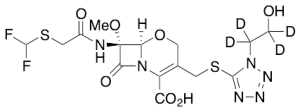
Flomoxef-d4 (90%)
$1,444.69 Add to cart View Product DetailsMolecular Formula : C15 D4 H14 F2 N6 O7 S2
-
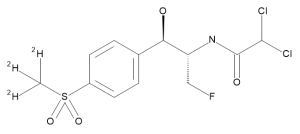
Florfenicol-d3
$246.68 Add to cart View Product DetailsMolecular Formula : C12D3H11Cl2FNO4S
-

Florfenicol-d3 Amine
$232.88 Add to cart View Product DetailsMolecular Formula : C10H11D3FNO3S
-
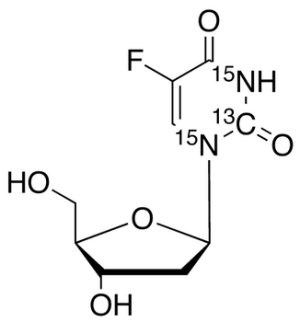
Floxuridine-13C,15N2
$331.20 Add to cart View Product DetailsMolecular Formula : C813CH11F15N2O5
-

Flt-3L, Human
$1,410.19 Add to cart View Product DetailsFms-related tyrosine kinase 3 ligand (Flt3L) is growth fator stimulates the proliferation and differentiation of hematopoietic multipotent progenitors and promotes proliferation of NK cells and dendritic cell subgroups by combination with other growth factors. Flt3L is produced by T cells and stromal fibroblasts, and targeted various cells including hematopoietic stem cells, B cells, T cells, dendritic cells, and NK cells. Flt3L binds to it cognate tyrosine kinase receptor Flt3 and activates JAK/STAT signaling pathway.Flt3L is a hematopoietic four helical bundle cytokine with structurally homologous to stem cell factor (SCF) and colony stimulating facor 1 (CSF-1) demonstrated four conserved cysteines and two glycosylation sites. Flt3L naturally as a non-disulfide-linked homodimer with multiple isoforms. The extracellular portion is approximately 160 amino acid residues in length and the cytoplasmic segment is approximately 20-30 amino acid residues in length.
-
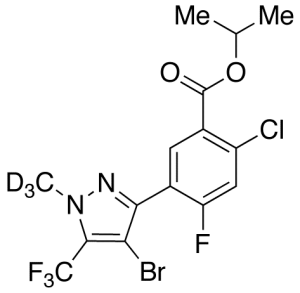
Fluazolate-d3
$264.79 Add to cart View Product DetailsMolecular Formula : C15H9D3BrClF4N2O2
-

Flubendazole-d3
$134.55 Add to cart View Product DetailsMolecular Formula : C16 2H3 H9 F N3 O3
-

Flubromazolam
$144.04 Add to cart View Product DetailsMolecular Formula : C17 H12 Br F N4
-
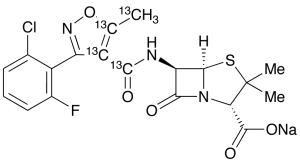
Flucloxacillin-13C4 Sodium
$295.84 Add to cart View Product DetailsMolecular Formula : C15 13C4 H16 Cl F N3 Na O5 S
-

Fluconazole N-Oxide
$217.35 Add to cart View Product DetailsMolecular Formula : C13H12F2N6O2
-

Fluconazole-d4
$225.98 Add to cart View Product DetailsMolecular Formula : C13 2H4 H8 F2 N6 O
-

Fludioxonil-13C2
$329.48 Add to cart View Product DetailsMolecular Formula : C1013C2H6F2N2O2
-

Fludioxonil-13C3
$420.04 Add to cart View Product DetailsMolecular Formula : C913C3H6F2N2O2
-

Fludrocortisone
$94.01 Add to cart View Product DetailsMolecular Formula : C21 H29 F O5
-

Fludrocortisone-d5 (Major)
$276.00 Add to cart View Product DetailsMolecular Formula : C21H24D5FO5
-
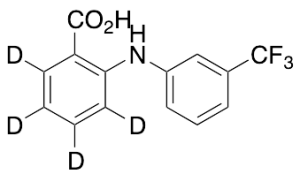
Flufenamic Acid-d4
$129.38 Add to cart View Product DetailsMolecular Formula : C14H6D4F3NO2
-
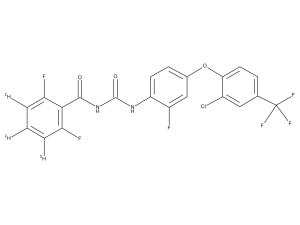
Flufenoxuron-d3 (2,6-Difluorobenzoyl-d3)
$324.30 Add to cart View Product DetailsMolecular Formula : C21 D3 H8 Cl F6 N2 O3
-

Flugestone
$102.64 Add to cart View Product DetailsMolecular Formula : C21H29FO4
-
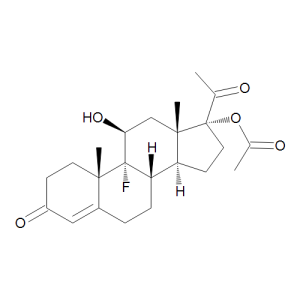
Flugestone 17-Acetate
$71.59 Add to cart View Product DetailsMolecular Formula : C23 H31 F O5
-

Flumazenil Carboxylic Acid-D3
$176.81 Add to cart View Product DetailsMolecular Formula : C13H7D3FN3O3
-

Flumequine-13C3
$208.73 Add to cart View Product DetailsMolecular Formula : 13C3 C11 H12 F N O3
-

Flumethasone-d3
$276.00 Add to cart View Product DetailsMolecular Formula : C22H25D3F2O5
-

Flunarizine-d8 Dihydrochloride
$154.39 Add to cart View Product DetailsMolecular Formula : C26H20D8Cl2F2N2






